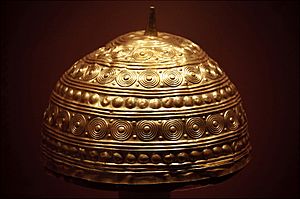Casco de Leiro facts for kids

The Casco de Leiro is a very special golden hat from a long, long time ago. It's also called the "Helmet of Leiro." This amazing golden object was probably used for ceremonies. It dates back to the end of the Bronze Age, which was around 1,000 to 800 BC. That's over 2,800 years ago! It was found in a town called Leiro in Galicia, Spain. When it was found, it was hidden with other items, making it a "hoard" or a hidden treasure.
Contents
What is the Casco de Leiro?
The Casco de Leiro is a golden cap shaped like half a ball. It is made from a single piece of gold. Craftsmen hammered the gold to create its shape. The entire cap is covered with beautiful designs. These designs were made using a technique called "repoussé." This means the patterns were pushed out from the back of the gold. The designs show repeated bumps and bands of circles. These circles are "concentric," meaning they are circles inside other circles.
How Big and Heavy Is It?
The Casco de Leiro is about 19.5 centimeters (about 7.7 inches) wide. It stands about 15 centimeters (about 5.9 inches) tall, not counting the top point. It weighs 270 grams, which is about the same as a small can of soda.
What Was It Used For?
Experts believe the Casco de Leiro had special uses. It might have been a "ritual basin." This means it could have held liquids for ceremonies. It has small holes made with a sharp tool, which might support this idea. It could also have been worn as a symbol of power. Imagine someone important wearing this golden hat!
Similar Golden Treasures
The designs on the Casco de Leiro are similar to other ancient golden items. These include tall, cone-shaped "golden hats" from the late Bronze Age. One famous example is the Golden Hat of Schifferstadt. It also looks a bit like the Comerford Crown from Ireland. Other similar items are golden bowls found in Spain, like those from Axtroki and the famous Treasure of Villena.
How Was the Casco de Leiro Found?
The Casco de Leiro was found by chance on April 7, 1976. A fisherman named José Vicente Somoza discovered it. He was at a rocky spot called Curruncho dos Porcos, near Leiro beach. This area is part of a large river mouth called the Ría de Arousa. The river system here was perfect for boats long ago.
The Discovery Story
José Vicente was clearing some earth to make space for a small shed. He wanted to keep his boat there. As he dug, his tool hit a rough clay pot. The pot broke open. Inside, he immediately saw a shining gold object! He knew it was important. He quickly told the local police, the Guardia Civil, and experts from the Department of Archaeology.
Where Is It Now?
The golden cap was then moved to the Museo Arqueolóxico e Histórico. This museum is in A Coruña, Spain. That's where it is kept safe and studied today.
See also
 In Spanish: Casco de Leiro para niños
In Spanish: Casco de Leiro para niños

